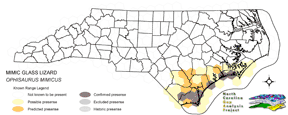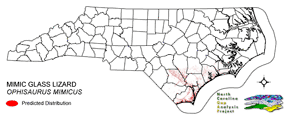
| Taxa: |
| Order: |
| Family: |
| Reptilia |
| Squamata |
| Anguidae |
| NatureServe Global Rank: |
| NatureServe State (NC) Rank: |
| G3 |
| S2 |
| Federal Status: |
| NC State Status: |
| FSC |
| SC |


| Land Unit |
| US Fish & Wildlife Service |
| US Forest Service |
| US National Park Service |
| US Department of Defense |
| NC State Parks |
| NC University System |
| NC Wildlife Res. Com. |
| NC Forest Service |
| NC Div. of Coastal Mgmt. |
| Local Governments |
| Non-Governmental Org. |
| Other Public Lands |
| Private Lands |
| GAP Status 1-2 |
| All Protected Lands |
| Statewide |
| Hectares |
| 165.69 |
| 2,655.81 |
| 7,723.17 |
| 13.77 |
| 421.92 |
| 301.50 |
| 899.46 |
| 2,943.81 |
| 0.00 |
| 29.52 |
| 722.52 |
| 51.30 |
| 98,160.39 |
| 1,940.58 |
| 15,922.26 |
| 114,088.86 |
| Acres |
| 409.43 |
| 6,562.65 |
| 19,084.36 |
| 34.03 |
| 1,042.59 |
| 745.02 |
| 2,222.61 |
| 7,274.31 |
| 0.00 |
| 72.95 |
| 1,785.39 |
| 126.77 |
| 242,559.56 |
| 4,795.28 |
| 39,344.75 |
| 281,919.66 |
| % of Dist. on |
| Prot. Lands |
| 1.0 % |
| 16.7 % |
| 48.5 % |
| < 0.1 % |
| 2.6 % |
| 1.9 % |
| 5.6 % |
| 18.5 % |
| 0.0 % |
| 4.5 % |
| 4.5 % |
| 0.3 % |
| 0.0 % |
| 12.2 % |
| ----- |
| ----- |
| % of Dist. on |
| All Lands |
| 0.1 % |
| 2.3 % |
| 6.8 % |
| < 0.1 % |
| 0.4 % |
| 0.3 % |
| 0.8 % |
| 2.6 % |
| 0.0 % |
| < 0.1 % |
| 0.6 % |
| < 0.1 % |
| 86.0 % |
| 1.7 % |
| ----- |
| ----- |
|
Found in the southeastern portion of the coastal plain, only as far north as Carteret County, and absent on the barrier islands (Palmer & Braswell 1995). Palmer and Braswell (1995) note feeding and reproductive habits are unknown and describe the Mimic glass lizard as 'probably the least-known species of Ophisaurus in the United States,' NATURE SERVE GLOBAL HABITAT COMMENTS: Typically in areas dominated by pines: sandy flatwoods and hillsides with longleaf pine, scattered oaks, ericaceous shrubs, and wiregrass; longleaf pine savanna (Palmer 1987). In areas of suitable habitat, can be found in early morning hours along roadways that have wide grassy berms (Ashton and Ashton 1991). NATURE SERVE STATE HABITAT COMMENTS: Open longleaf pine forests which are carefully and periodically burned provide optimal habitat. Most individuals have been observed on roads through flatwoods and savannas and along sand ridges. |
| Code | Name | Description | NC Natural Heritage Program Equivalent |
| 97 | Mesic Longleaf Pine | Longleaf pine woodlands without a major scrub oak component. Slash or loblolly pines may be present as well. | Mesic Pine Flatwoods |
| 42 | Xeric Longleaf Pine | Sandhills including a range of longleaf pine density from predominantly wiregrass, scrub oak dominated to true longleaf pine woodland. This does not include mesic or saturated flatwood types. | Xeric Sandhill Scrub, Pine/Scrub Oak Sandhill, Coastal Fringe Sandhill |
| 46 | Xeric Oak - Pine Forests | Mixed forest dominated by yellow pines with white or northern red oaks co-dominating. | Pine Oak Heath |
| 232 | Xeric Pine-Hardwood Woodlands and Forests | Mixed forest dominated by yellow pines with drier oaks including southern red, post, and chestnut oaks. | Dry Oak Hickory Forest |
|
Palmer, W. M. 1992. OPHISAURUS MIMICUS. Cat. Am. Amph. Rept. 543.1-543.2.
Conant, R. and J. T. Collins. 1991. A field guide to reptiles and amphibians:eastern and central North America. Third edition. Houghton Mifflin Co., Boston, Massachusetts. 450 pp. Palmer, W. M., and A. L. Braswell. 1995. Reptiles of North Carolina. North Carolina State Museum of Natural Sciences, University of North Carolina Press, Chapel Hill, North Carolina. McConkey, E. H. 1954. A systematic study of the North American lizards of the genus OPHISAURUS. Am. Midl. Nat. 51:133-169. Mount, R. H. 1975. The Reptiles and Amphibians of Alabama. Auburn University Agricultural Experiment Station, Auburn, Alabama. vii + 347 pp. Palmer, W. M. 1987. A new species of glass lizard (Anguidae:OPHISAURUS) from the southeastern United States. Herpetologica 43:415-423. Ashton, R. E., Jr., and P. S. Ashton. 1991. Handbook of reptiles and amphibians of Florida. Part two. Lizards, turtles & crocodilians. Revised second edition. Windward Pub., Inc., Miami. 191 pp. |
For more information please contact them at:
NC-GAP Analysis Project
Dept. of Zoology, NCSU
Campus Box 7617
Raleigh, NC 27695-7617
(919) 513-2853
www.basic.ncsu.edu/ncgap